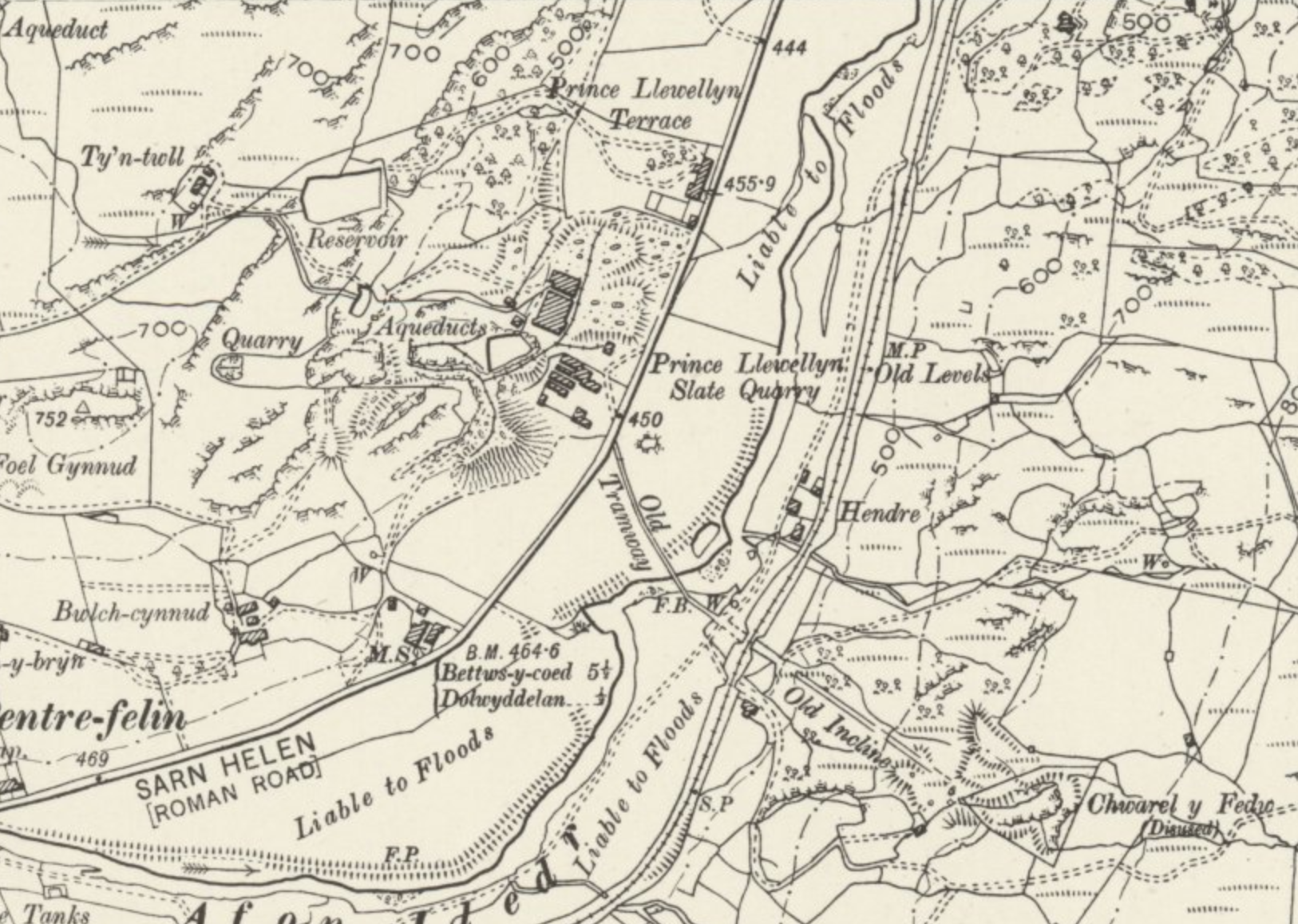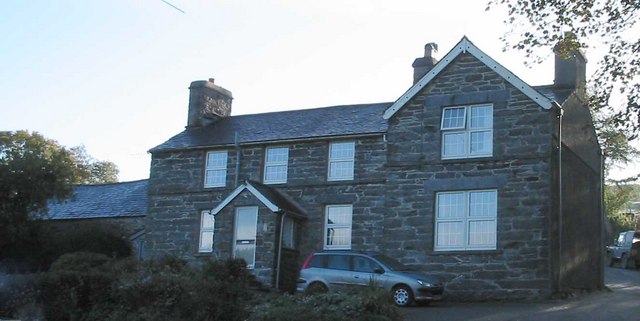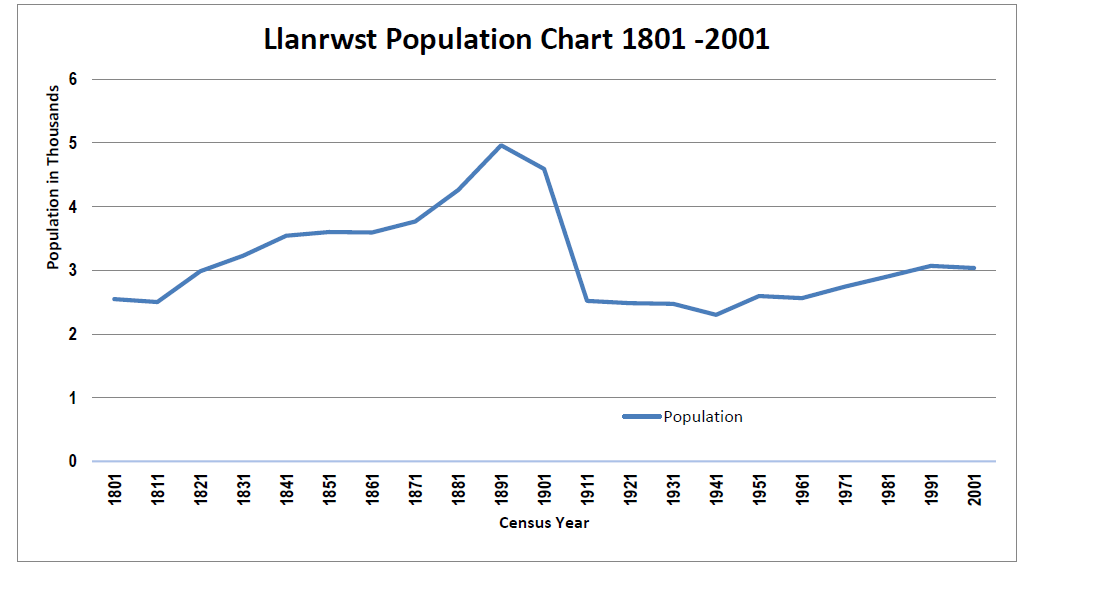|
Prince Llewellyn Quarry
The Prince Llewellyn quarry (also known as Bwlch Cynnud quarry, Y Foel quarry, Hendre Ddu quarry, or Prince Llywelyn quarry) was a slate quarry that stands on the west side of the Lledr Valley, ENE of Dolwyddelan. It was worked from around 1820 to 1934. History Early years The quarry opened around 1820, and was originally an open pit. The quarry was expanded in the 1840s. The road from Betws-y-Coed to Dolwyddelan was re-routed in 1846 to allow construction of a new quarry mill and Prince Llewelyn Terrace to house quarry workers. The new mill contained four horizontal sandsaws driven by a steam engine, which was later replaced with a waterwheel. An incline led down from the pit to the mill level. Chwarel Fedw In 1873, the quarry was owned by John Jones and employed about 40 men. The quarry was worked in conjunction with Chwarel Fedw on the east side of the valley. A tramway was built across the Afon Lledr to connect the two quarries and slate from Chwarel Fedw was taken ac ... [...More Info...] [...Related Items...] OR: [Wikipedia] [Google] [Baidu] |
Conwy County Borough
Conwy County Borough ( cy, Bwrdeistref Sirol Conwy) is a county borough in Wales. It borders Gwynedd to the west and south, and Denbighshire to the east. Other settlements in the county borough include Abergele, Betws-y-Coed, Colwyn Bay, Conwy, Llandudno, Llandudno Junction, Llanfairfechan, Llanrwst, and Penmaenmawr. Geography The River Conwy, after which the county borough is named, lies wholly within the area: rising in Snowdonia and flowing through Llanrwst and Trefriw en route to the Irish Sea by Conwy. The river here marks the border between the historic counties of Caernarfonshire and Denbighshire. One third of the land area of the county borough lies in the Snowdonia National Park, and the council appoint three of the 18 members of the Snowdonia National Park Authority. Its total area is , making it slightly larger than Hong Kong. The eastern part includes the larger section of Denbigh Moors. The vast majority of the population live on the coast; the only settlement o ... [...More Info...] [...Related Items...] OR: [Wikipedia] [Google] [Baidu] |
Owen Gethin Jones
Owen Gethin Jones (1816 - 1883), was a Welsh building contractor, quarry owner and prominent poet. Early life Jones was born on 1 May 1816 at Tyn-y-Cae, Penmachno, to parents Owen and Grace Jones. Family In 1843, Jones married Ann Owen of Bwlch Bach, Dolwyddelan. Their son Owen Jones died in 1877 of liver failure. Their youngest daughter Jeanie G. Jones was married in 1884. Writer Jones was a prominent poet in Eisteddfod circles and was a noted local historian. His essay on Penmachno, written in the mid 19th century, was first published in 1884 (after his death) in "Gweithiau Gethin" ''(The Works of Gethin)''. The essay refers to the first nonconformist sermon in the parish in about 1784 at Penrhyn Uchaf; it describes the buildings at Dugoed farm () (the oldest part of the farmhouse was built around 1517) and reflects on the possible sites of historical significance on the farm itself, including Tomen y Castell as a possible fort and the field Cae'r Braint ("Field of Honou ... [...More Info...] [...Related Items...] OR: [Wikipedia] [Google] [Baidu] |
Slate Mines In Conwy County Borough
Slate is a fine-grained, foliated, homogeneous metamorphic rock derived from an original shale-type sedimentary rock composed of clay or volcanic ash through low-grade regional metamorphism. It is the finest grained foliated metamorphic rock. Foliation may not correspond to the original sedimentary layering, but instead is in planes perpendicular to the direction of metamorphic compression. The foliation in slate is called "slaty cleavage". It is caused by strong compression causing fine grained clay flakes to regrow in planes perpendicular to the compression. When expertly "cut" by striking parallel to the foliation, with a specialized tool in the quarry, many slates will display a property called fissility, forming smooth flat sheets of stone which have long been used for roofing, floor tiles, and other purposes. Slate is frequently grey in color, especially when seen, en masse, covering roofs. However, slate occurs in a variety of colors even from a single locality; for exam ... [...More Info...] [...Related Items...] OR: [Wikipedia] [Google] [Baidu] |
Syncline
In structural geology, a syncline is a fold with younger layers closer to the center of the structure, whereas an anticline is the inverse of a syncline. A synclinorium (plural synclinoriums or synclinoria) is a large syncline with superimposed smaller folds. Synclines are typically a downward fold (synform), termed a synformal syncline (i.e. a trough), but synclines that point upwards can be found when strata have been overturned and folded (an antiformal syncline). Characteristics On a geologic map, synclines are recognized as a sequence of rock layers, with the youngest at the fold's center or ''hinge'' and with a reverse sequence of the same rock layers on the opposite side of the hinge. If the fold pattern is circular or elongate, the structure is a basin. Folds typically form during crustal deformation as the result of compression that accompanies orogenic mountain building. Notable examples * Powder River Basin, Wyoming, US * Sideling Hill roadcut along Interstate ... [...More Info...] [...Related Items...] OR: [Wikipedia] [Google] [Baidu] |
Nod Glas Formation
The Nod Glas Formation (also known as the Nod Glas Black Shale, the Cadnant Shale, the Penarwel Mudstones or just Nod Glas) is an Ordovician lithostratigraphic group (a sequence of rock strata) in Mid Wales. The rock of the formation is made up of pyritous, graptolitic mudstone that is generally black in colour. It weathers to a soft, very well cleaved and coal-like material. The formation runs from Conwy in the north, down to Cardigan Bay in the area around Aberdyfi and Tywyn, though it is not a continuous over this area. The formation is the topmost of the Caradoc Series in North Wales, and the name refers to all the black shale beds in the area. In South Wales, the equivalent beds of shale are called the Dicranograptus Shales. North Wales Between Tywyn and Aberllefenni the Nod Glas Formation is about thick. The section between Aberllefenni and Aberangell is the type locality for the formation. North of Corris, towards Bwlch y Groes, the formation gradually thins and ceases ... [...More Info...] [...Related Items...] OR: [Wikipedia] [Google] [Baidu] |
1899 Map Of Prince Llewellyn Quarry
Events January 1899 * January 1 ** Spanish rule ends in Cuba, concluding 400 years of the Spanish Empire in the Americas. ** Queens and Staten Island become administratively part of New York City. * January 2 – **Bolivia sets up a customs office in Porto Acre, Puerto Alonso, leading to the Brazilian settlers there to declare the Republic of Acre in a revolt against Bolivian authorities. **The first part of the Jakarta Kota–Anyer Kidul railway on the island of Java is opened between Batavia Zuid (Jakarta Kota railway station, Jakarta Kota) and Tangerang railway station, Tangerang. * January 3 – Hungarian Prime Minister Dezső Bánffy fights an inconclusive duel with his bitter enemy in parliament, Horánszky Nándor. * January 4 – **U.S. President William McKinley's declaration of December 21, 1898, proclaiming a policy of benevolent assimilation of the Philippines as a United States territory, is announced in Manila by the U.S. commander, General Elwel ... [...More Info...] [...Related Items...] OR: [Wikipedia] [Google] [Baidu] |
First World War
World War I (28 July 1914 11 November 1918), often abbreviated as WWI, was one of the deadliest global conflicts in history. Belligerents included much of Europe, the Russian Empire, the United States, and the Ottoman Empire, with fighting occurring throughout Europe, the Middle East, Africa, the Pacific, and parts of Asia. An estimated 9 million soldiers were killed in combat, plus another 23 million wounded, while 5 million civilians died as a result of military action, hunger, and disease. Millions more died in genocides within the Ottoman Empire and in the 1918 influenza pandemic, which was exacerbated by the movement of combatants during the war. Prior to 1914, the European great powers were divided between the Triple Entente (comprising France, Russia, and Britain) and the Triple Alliance (containing Germany, Austria-Hungary, and Italy). Tensions in the Balkans came to a head on 28 June 1914, following the assassination of Archduke Franz Ferdina ... [...More Info...] [...Related Items...] OR: [Wikipedia] [Google] [Baidu] |
Llanrwst
Llanrwst ('church or parish of Saint Grwst'; ) is a market town and community on the A470 road and the River Conwy, in Conwy County Borough, Wales, and the historic county of Denbighshire. It developed round the wool trade and became known also for the making of harps and clocks. Today, less than a mile from the edge of Snowdonia, its main pursuit is tourism. Notable buildings include almshouses, two 17th-century chapels, and the Parish Church of St Grwst, which holds a stone coffin of Llywelyn the Great. The 2011 census gave it a population of 3,323. History The site of the original church dedicated to St Grwst was Cae Llan in Llanrwst (land now occupied by the Seion Methodist Chapel). The current church of St Grwst is on land which was donated in about 1170 by Rhun ap Nefydd Hardd, a member of the royal family of the Kingdom of Gwynedd, specifically to build a new church so dedicated. Llanrwst developed around the wool trade, and for a long time the price of wool for the ... [...More Info...] [...Related Items...] OR: [Wikipedia] [Google] [Baidu] |
Penrhyn Quarry
The Penrhyn quarry is a slate quarry located near Bethesda, North Wales. At the end of the nineteenth century it was the world's largest slate quarry; the main pit is nearly long and deep, and it was worked by nearly 3,000 quarrymen. It has since been superseded in size by slate quarries in China, Spain and the USA. Penrhyn is still Britain's largest slate quarry but its workforce is now nearer 200. History The first reference to slate extraction at Penrhyn is from 1570, when the quarry is mentioned in a Welsh poem. The quarry was developed in the 1770s by Richard Pennant, later Baron Penrhyn. Much of his early working was for local use only as no large scale transport infrastructure was developed until Pennant's involvement. From then on, slates from the quarry were transported to the sea at Port Penrhyn on the narrow gauge Penrhyn Quarry Railway built in 1798, one of the earliest railway lines. In the 19th century the Penrhyn Quarry, along with the Dinorwic quarry, dom ... [...More Info...] [...Related Items...] OR: [Wikipedia] [Google] [Baidu] |
Slate Industry In Wales
The existence of a slate industry in Wales is attested since the Roman period, when slate was used to roof the fort at Segontium, now Caernarfon. The slate industry grew slowly until the early 18th century, then expanded rapidly until the late 19th century, at which time the most important slate producing areas were in northwest Wales, including the Penrhyn Quarry near Bethesda, the Dinorwic Quarry near Llanberis, the Nantlle Valley quarries, and Blaenau Ffestiniog, where the slate was mined rather than quarried. Penrhyn and Dinorwig were the two largest slate quarries in the world, and the Oakeley mine at Blaenau Ffestiniog was the largest slate mine in the world. Slate is mainly used for roofing, but is also produced as thicker slab for a variety of uses including flooring, worktops and headstones.Lindsay p. 133 Up to the end of the 18th century, slate was extracted on a small scale by groups of quarrymen who paid a royalty to the landlord, carted slate to the ports, and ... [...More Info...] [...Related Items...] OR: [Wikipedia] [Google] [Baidu] |
Cable Railway
Cable may refer to: Mechanical * Nautical cable, an assembly of three or more ropes woven against the weave of the ropes, rendering it virtually waterproof * Wire rope, a type of rope that consists of several strands of metal wire laid into a helix ** Arresting cable, part of a system used to rapidly decelerate an aircraft as it lands ** Bowden cable, a mechanical cable for transmitting forces * Rope generally, especially a thick, heavy ("cable laid") variety Transmission * Electrical cable, an assembly of one or more wires which may be insulated, used for transmission of electrical power or signals ** Coaxial cable, an electrical cable comprising an inner conductor surrounded by a flexible, tubular insulating layer, coated or surrounded by a tubular conducting shield ** Power cable, a cable used to transmit electrical power ** Submarine communications cable, a cable laid on the sea bed to carry telecommunication signals between land-based stations * Fiber-optic cable, a cable co ... [...More Info...] [...Related Items...] OR: [Wikipedia] [Google] [Baidu] |
Dolwyddelan
Dolwyddelan ( ; ; ) – in Victorian times, often spelled Dolyddelen – is a village and community in Conwy county borough, Wales, on the main A470 road between Blaenau Ffestiniog and Betws-y-Coed. As a community, the population of Dolwyddelan was recorded in the 2001 Census as 427, and 55.8% of those residents could speak Welsh. The population increased to 474 in the 2011 census with the proportion of Welsh speakers falling to 50.8%. Name The spelling of the village's name has varied over the years, though there appear to be two primary spellings with two primary meanings. The common modern spelling "Dolwyddelan" is translated as "Gwyddelan's meadow", referring to Saint Gwyddelan, an Irish missionary of the 6th century, after whom the parish church is named. There is some question as to which came first, the castle or the name. Saint Gwyddelan is believed to have arrived around 600 AD. A variant of this spelling is Dolwyddelen, which was particularly used by the ... [...More Info...] [...Related Items...] OR: [Wikipedia] [Google] [Baidu] |



.png)



%2C_Blaenau_Ffestiniog_(14117319357).jpg)
